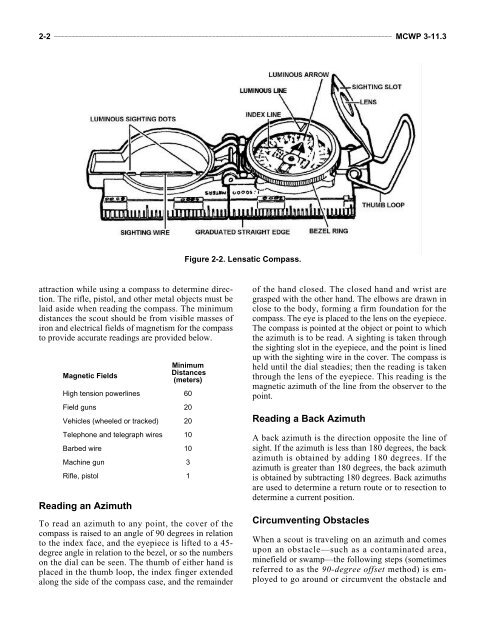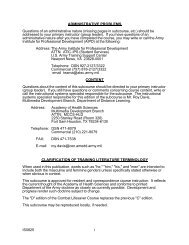MCWP-3-11.3-Scouting-and-Patrolling
MCWP-3-11.3-Scouting-and-Patrolling
MCWP-3-11.3-Scouting-and-Patrolling
Create successful ePaper yourself
Turn your PDF publications into a flip-book with our unique Google optimized e-Paper software.
2-2 ______________________________________________________________________________________________ <strong>MCWP</strong> 3-<strong>11.3</strong>Figure 2-2. Lensatic Compass.attraction while using a compass to determine direction.The rifle, pistol, <strong>and</strong> other metal objects must belaid aside when reading the compass. The minimumdistances the scout should be from visible masses ofiron <strong>and</strong> electrical fields of magnetism for the compassto provide accurate readings are provided below.Magnetic FieldsReading an AzimuthMinimumDistances(meters)High tension powerlines 60Field guns 20Vehicles (wheeled or tracked) 20Telephone <strong>and</strong> telegraph wires 10Barbed wire 10Machine gun 3Rifle, pistol 1To read an azimuth to any point, the cover of thecompass is raised to an angle of 90 degrees in relationto the index face, <strong>and</strong> the eyepiece is lifted to a 45-degree angle in relation to the bezel, or so the numberson the dial can be seen. The thumb of either h<strong>and</strong> isplaced in the thumb loop, the index finger extendedalong the side of the compass case, <strong>and</strong> the remainderof the h<strong>and</strong> closed. The closed h<strong>and</strong> <strong>and</strong> wrist aregrasped with the other h<strong>and</strong>. The elbows are drawn inclose to the body, forming a firm foundation for thecompass. The eye is placed to the lens on the eyepiece.The compass is pointed at the object or point to whichthe azimuth is to be read. A sighting is taken throughthe sighting slot in the eyepiece, <strong>and</strong> the point is linedup with the sighting wire in the cover. The compass isheld until the dial steadies; then the reading is takenthrough the lens of the eyepiece. This reading is themagnetic azimuth of the line from the observer to thepoint.Reading a Back AzimuthA back azimuth is the direction opposite the line ofsight. If the azimuth is less than 180 degrees, the backazimuth is obtained by adding 180 degrees. If theazimuth is greater than 180 degrees, the back azimuthis obtained by subtracting 180 degrees. Back azimuthsare used to determine a return route or to resection todetermine a current position.Circumventing ObstaclesWhen a scout is traveling on an azimuth <strong>and</strong> comesupon an obstacle—such as a contaminated area,minefield or swamp—the following steps (sometimesreferred to as the 90-degree offset method) is employedto go around or circumvent the obstacle <strong>and</strong>



